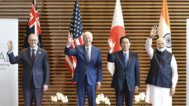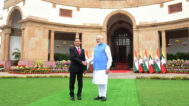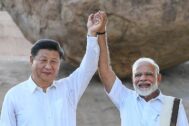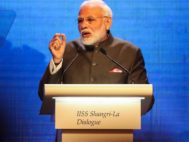Authors
Satu Limaye

Dr. Satu Limaye is Director, East West Center in Washington and Senior Advisor, Center for Naval Analyses (CNA) and Senior Fellow on Asia History and Policy at the Foreign Policy Institute at Paul H. Nitze School of Advanced International Studies (SAIS). He created and directs the Asia Matters for America initiative, a resource for credible, non-partisan information, graphics, analysis and news on national, state and local levels US-Asia Pacific relations. He is Founding Editor of the Asia-Pacific Bulletin, an editor of Global Asia and on the international advisory council of the journal Contemporary Southeast Asia. Dr. Limaye is published in leading media and journals and serves as a reviewer for numerous publications, foundations and fellowship programs. He was a Research Staff Member of the Strategy and Resources Division at the Institute for Defense Analyses (IDA) and Director of Research and Publications at the Asia-Pacific Center for Security Studies (APCSS), a direct reporting unit of U.S. Pacific Command. He has been an Abe Fellow at the National Endowment for Democracy and a Henry Luce Scholar at the Japan Institute of International Affairs (JIIA) in Tokyo. He is a magna cum laude and Phi Beta Kappa graduate of Georgetown University and received his doctorate from Oxford University (Magdalen College) where he was a George C. Marshall Scholar.
Articles by Satu Limaye

India - East Asia
January — December 2023A Year of India Everything Everywhere All at Once
In 2023, the Indo-Pacific was something of a backdrop to India’s robust global activities, including the presidency of the Group of Twenty (G20), chairing for the first time the Shanghai Cooperation Organization summit, participating in the Group of Seven summit, convening for the first time the Voice of Global South summits, and co-chairing with the United States the Partnership for Global Infrastructure and Investment and the India-Middle East-Europe Economic Corridor initiatives launched on the sidelines of the September G20 Summit in Delhi. Comparatively, India’s Indo-Pacific engagements were less high-profile and leader-led but still numerous and active. India’s low-level but wide-ranging defense diplomacy is particularly noteworthy. Prime Minister Modi and External Affairs Minister Jaishankar, while pre-occupied by India’s role in global diplomacy, made important visits in the Indo-Pacific, with the PM making four country stops on two regional trips to the region; the first in May to the G7 Summit in Hiroshima, followed by stops in Papua New Guinea and Australia, and another in September to Jakarta, Indonesia for the annual ASEAN-led summit meetings, including the annual India-ASEAN dialogue.

India - East Asia
January — December 2022India’s Ongoing “Strategic Correction to the East” during 2022
India’s East Asia relations in 2022 followed the arc articulated by External Affairs Minister S. Jaishankar’s address at Chulalongkorn University in Thailand in August. He recalled three decades ago India made a “strategic correction to the East…[o]riginally…contemplated as an economic measure, with trade and investment at its core” and mostly focused on ASEAN. He said the geography, concepts, and assessments of India’s Indo-Pacific vision have expanded “to cover Japan, Korea and China, and in due course, Australia as also other areas of Pacific Islands…[and] facets of cooperation also increased…now cover[ing] connectivity in various forms, people-to-people ties and more recently, defense and security.” And while dutifully referencing India’s Indo-Pacific policies including Security and Growth for All in the Region (SAGAR) and the Indo-Pacific Oceans’ Initiative (IPOI), he gave the most attention to the revitalized Quadrilateral Security Dialogue (“Quad”). The highlights of India in East Asia in 2022 were numerous Quad meetings, the inaugural India-ASEAN Defense Ministers’ Meeting, the second India-Japan 2+2 Ministerial Dialogue, the Australian deputy prime minister and minister for defense’s visit to India, and India’s defense minister visits to Vietnam and Mongolia. Defense and security engagement included numerous exercises, defense dialogues, military-to-military exchanges, and navy ship visits.

ROUNDTABLE
October 26, 2022China’s Foreign Relations After the Party Congress

India - East Asia
January — December 2021Focused on the “Quad” and Border Disputes with China
India’s relations with East Asia during 2021 were characterized by two major developments; increasing interaction with the United States, Japan, and Australia as part of the “Quad” and painstaking efforts at border disengagement and dispute management with China. Within these preoccupations, India continued a robust if undramatic set of engagements (mostly virtually) across East Asia. India’s active East Asia engagements were notable, coming as they did amid New Delhi taking up a nonpermanent seat of the United Nations Security Council, finding its footing with the new Biden administration, addressing a February coup next door in Myanmar, battling a major wave of the delta variant of the COVID-19 virus, and contending with the fallout of the US withdrawal from Afghanistan in the summer, as well as participating in the COP26 Summit and the Summit for Democracies that President Biden hosted at the end of the year.

India - East Asia
January — December 2020India-East Asia Relations: Acting Across the Indo-Pacific, Actually and Virtually
Despite the COVID-19 global pandemic, India’s engagement with East Asia during 2020 remained reasonably active, both actually and virtually. India’s external affairs minister, S. Jaishankar, took several opportunities to emphasize that the Indo-Pacific concept (i.e., the inclusion of India and the Indian Ocean region) has gained wider acceptance. In his opening remarks at the 2nd Quad Ministerial Meeting, for example, he said “[i]t is a matter of satisfaction that the Indo-Pacific concept has gained increasingly wider acceptance.” And he also repeatedly highlighted India’s commitment to the concept, saying “The Indo-Pacific Ocean’s Initiative that [India] tabled at the East Asia Summit [in 2019] is a development with considerable promise in that context.” He pointedly highlighted India’s actions at the frontier of the western Pacific, telling an Indonesia-Australia convened town hall that “[i]t is revealing that in the midst of a global health crisis, Indian diplomacy has actually put its Indo-Pacific approach into practice. We provided assistance to Solomon Islands, Nauru, Papua New Guinea, Kiribati, Tonga, Tuvalu and Palau for procurement of medical equipment and supplies to assist in their response to COVID-19.” However, on two major counts—the decision by most regional countries to sign the Regional Comprehensive Economic Partnership agreement (RCEP) without India (which had dropped out of the negotiations last year) and the confrontation-filled Sino-India relationship—India’s East Asian relations were complicated rather than positive. Brighter spots included progress on the “Quad Consultations” (US, Japan, Australia, and India) and concomitant steady progress in bilateral security ties to Japan and Australia.

India - East Asia
January — December 2019Domestic Distractions Disrupt, but Do Not Derail, India’s Engagement
India’s 2019 interactions with the Indo-Pacific were active if measured by diplomatic outreach and defense engagements, but ended with two “whimpers” rather than “bangs.” The first was the decision to drop out of the Regional Comprehensive Economic Partnership (RCEP), announced at the ASEAN-convened summits in Bangkok in November. Until the announcement, India seemed ready to join the agreement. The second was the postponement of Japanese Prime Minister Abe Shinzo’s scheduled trip to Assam and Manipur states in northeast India for an annual exchange of prime ministerial visits. The postponement was reportedly decided after discussions between the two governments in the wake of violence against the Indian government’s controversial citizenship bill. The two unrelated developments did speak to two common themes: the first being the limits of India’s East Asia relations, and the second the occasional interruption, by domestic drivers, of India’s continued upward (if not steep) trajectory in relations with the Indo-Pacific region.

India - East Asia
January — December 2018India Continues Involvement & Integration with the Indo-Pacific/East Asia in 2018
Beginning in 2000, and in almost every year since, Comparative Connections has carried an annual assessment of India-East Asia relations; on occasion this assessment has been combined with one on India-United States relations. The approach to this series of articles has been to review India’s relations with East Asia’s individual countries and subregions such as Southeast Asia and the Pacific Islands. This year our annual assessment of India-East Asia relations takes a new approach: assessing India’s involvement and integration with East Asia thematically (diplomacy, defense, trade/investment and multilateralism) incorporating updates on select/relevant countries during 2018. The impetus to the change is to arrive at a better appreciation of the most important elements of India’s involvement and integration into East Asia’s diplomatic, defense-security, and economic environment.

India - East Asia
September — December 2017Welcomed by Washington, Contested by China, Engaged with East Asia
Progress was not dramatic, but the combination of a US-India relationship strengthened and networked in the context of the Indo-Pacific, ongoing China-India tensions, and India’s continued incremental advances in regional ties is consolidating India-East Asia relations. The Trump administration, in its first year in office, welcomed Prime Minister Modi and articulated India’s importance to both its South Asia and Indo-Pacific policies, including trilateral and quadrilateral arrangements among the US, Japan, India, and Australia. Mid-year, India and China engaged in a tense two-month standoff on the Doklam Plateau, highlighting yet another element of longstanding territorial and border disputes and adding to the list of accumulated grievances. India’s relations with other East Asian countries, however, advanced on the diplomatic and defense fronts. India’s own emphases in its East Asia outreach included maritime cooperation, seeking to engage East Asian partners in India’s states, building new bilateral mechanisms to harness relations, and participating in regional multilateral groupings to institutionalize regional relationships and engagements.

India - East Asia
January — December 2016Robust but not Riveting
India deployed its prime minister, president, and vice president as well as key Cabinet officials across East Asia and the Pacific in 2016 in support of its “Act East Policy.” Since 2015 was the first full year of India “acting east” under Prime Minister Narendra Modi’s administration, 2016 was not expected to be a defining year in India-East Asia relations and it was not; rather, India’s engagement was robust but not riveting. After years of negotiating, a nuclear deal between India and Japan was one major development. More troubling, trade and investment ties were lackluster due to a range of international as well as specific bilateral factors, although India continues to participate in negotiations for the Regional Comprehensive Economic Partnership (RCEP) agreement. India-China relations were noticeably cool and contentious. Still, India pursued broad and innovative outreach initiatives despite more pressing priorities, limited leverage, and East Asia’s own flux, contestations, and uncertainties. An example of innovation was President Mukherjee’s first-ever state visit to Papua New Guinea. He also made the first Indian presidential visit to China since 2000. Meanwhile, Vice President Ansari made a first-ever vice presidential visit to Brunei and to Thailand after a 50-year gap. So, India “acted east” as Modi promised soon after taking office in 2014, but it was hardly a bravura performance.
US - India
March — August 2016Progress on Defense while Economic Issues Lag
Since relations were reset following President Obama’s visit to India in January 2015, there have been three visits to the US by Prime Minister Modi. The US and India have also conducted two iterations of the Strategic and Commercial Dialogue (S&CD), exchanged multiple Cabinet-level visits, and announced new initiatives to broaden and deepen dialogue and produce outcomes. Over the past year and a half, the absence of drama has allowed for notable progress in the area of defense relations, but just as notably little progress on key trade and investment issues even as bilateral trade and investment grows. After three decades and three US presidents with strong commitments to the bilateral relationship, it remains to be seen whether a new US president will reciprocate Modi’s expressed and demonstrated interest in strong US-India relations.